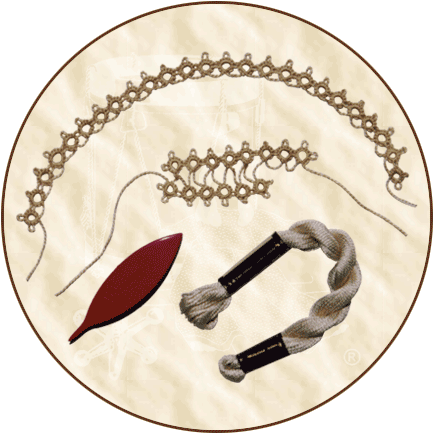.
Continued from product description
on Home Crafts' Page One...
Historical
Background: Tatting is actually a method of making lace
by knotting. The knots are made on a carrier thread and then
formed into rings and chains. The tatting continues until a lovely
pattern is achieved. A long row of rings can be added to the
edge of handkerchiefs, collars, linens, or any article of clothing.
More intricate patterns are used to make doilies, place mats,
decorations, stars, hearts, angles, wreaths, bookmarks, and the
list could go on. There are many tatting pattern books available
today for the tatting enthusiast.
Tatting may have originated in 16th-century Italy. Tatting
resembles macramé, which is considered to be one of the
oldest types of lace. Examples of this kind of lace have been
found in Egyptian tombs. Egyptian hieroglyphic texts give evidence
that the method of manipulating thread with a shuttle (called
a "makouk") into circles and rings was practiced. This
may have been the craft that evolved into tatting. Tatting also
resembles knotting, which is also made with a shuttle. Knotting
may have spread from China westward after the Middle East was
opened by Dutch trade routes.
Tatting became very popular in England in the late-16th century.
Previously, making lace involved using a pillow, many long wooden
bobbins, lots of pins, needle and thread, and a net foundation.
This was exhausting work. Tatted lace could, however, be made
with just a shuttle, one's hands, and some thread. Tatting became
most popular around 1850. Mlle. Elenore Riego de la Branchardiere
was appointed as Artiste in Needlework to Her Royal Highness,
the Princess of Wales. She was known as the "queen of tatting"
and wrote 11 books on the subject between 1850 and 1868. She
tatted with a shuttle and introduced "joining with a needle"
in 1850. Needle tatting was first mentioned in "The Ladies'
Work-Table Book" published in London, England, in 1843.
Needle tatting uses a long blunt, non-tapered, five-inch needle.
Other types of tatting that have been referenced are finger tatting
and Japanese hook tatting. Finger tatting only involves the fingers
and no shuttle or needle is required. Japanese hook tatting requires
the use of a long, double-ended crochet hook.
Shuttle tatting was obviously very graceful to watch as the
hands turned and moved back and forth with the shuttle. Women
liked to show off their work and their fancy shuttles made of
bone, ivory, mother of pearl, and ones studded with jewels. Tatting
was so popular that some of the more prominent women had their
portraits painted with shuttles. The National Gallery at London
houses a portrait by Sir Joshua Reynolds (1723-1792) of the Countess
of Albemarle, which shows her tatting. Another painting in Versailes,
by J.M. Nattier, is of Madame Adelaide of France. She is holding
a rather large tatting shuttle in this painting. Most of the
tatting shuttles we see today are small. Large shuttles were
used in the 18th century for thicker cord, usually silk. A six-inch
shuttle is recorded in Musee de Cluny in Paris, France, where
the finest of the world's historic shuttles are to be found.













